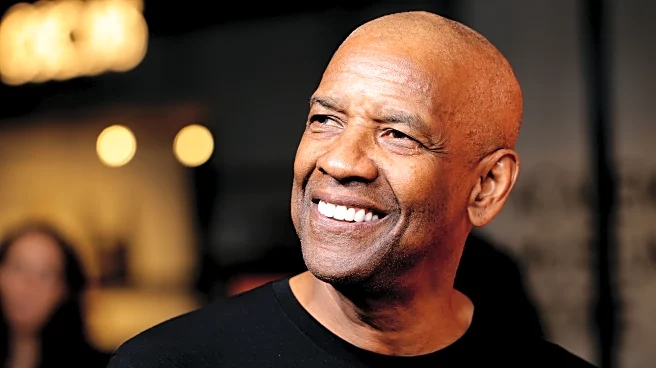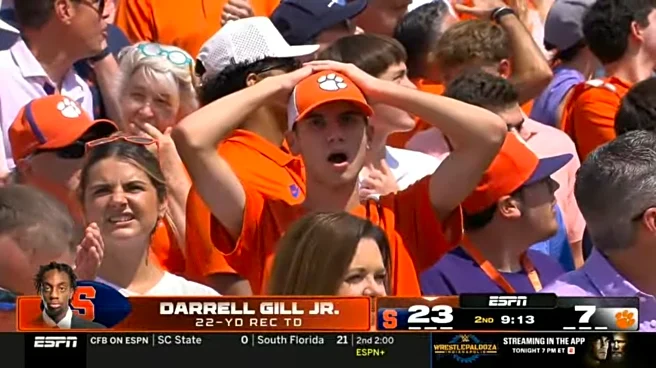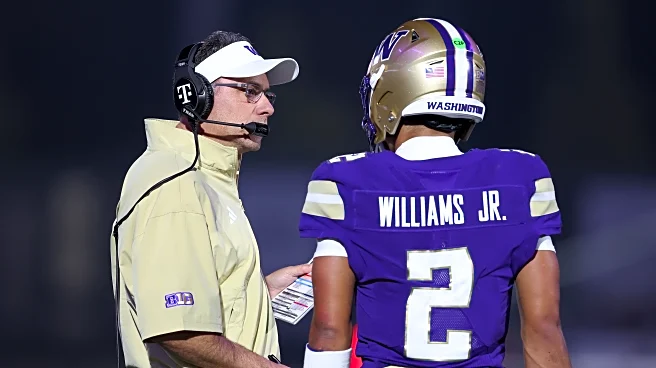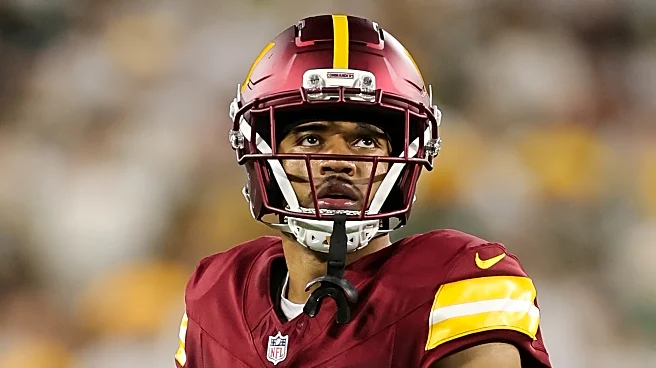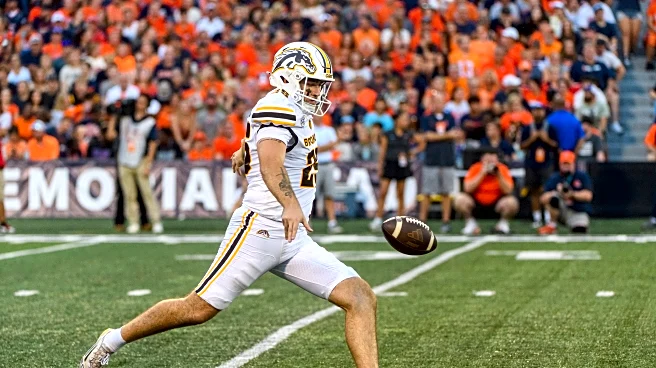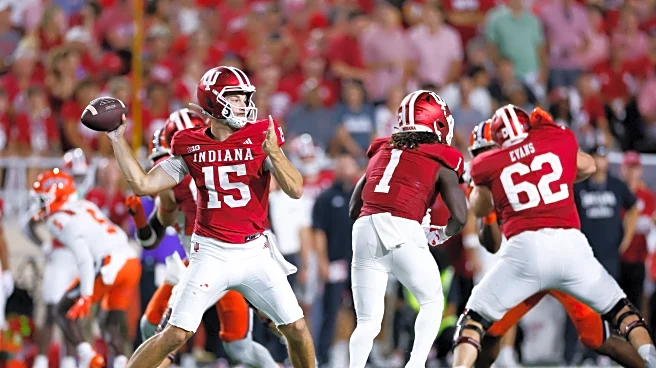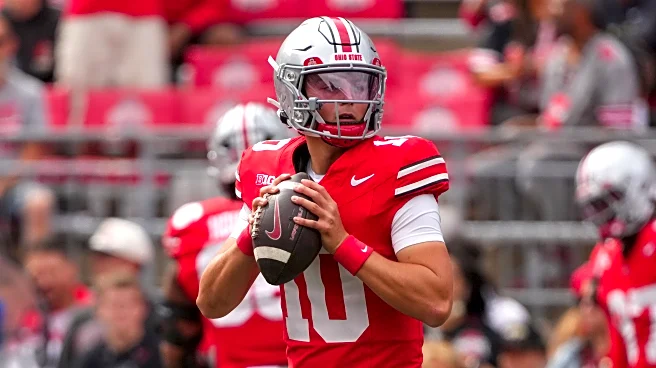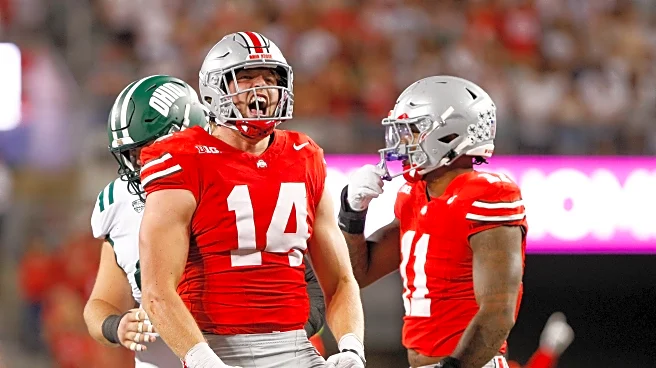Special thanks to Andrew Burd and Vince Fadale of The Nittany Blues for joining me to discuss Penn State’s roster on this week’s podcast:
Nota bene: Per longstanding practice, all statistics in this article
for the 2025 season and in reference to previous seasons are taken only from games against FBS opponents during meaningful play, except as specifically noted. Even when referring to Penn State’s week 3 game against FCS Villanova, garbage time — starting midway through the 3rd quarter — is excluded.
Offense

The biggest surprise and most notable change to Penn State’s offense since last year is that they have yet to leverage their usual strength at the offensive line even against light competition. I’ve been very impressed with the work that OL coach Trautwein has done to this point since head coach Franklin made the change after the 2019 season (longtime fans may recall that dominant offensive line play wasn’t a given at PSU, and that their last run of success from 2016-19 was often in spite of the o-line rather than because of it, as with the 2022-present one). The 2025 lineup is entirely comprised of linemen who started last year and Andrew and I anticipated this to be the top line in the conference if not the country when we spoke over the Summer, so it’s been quite a shock to see a decline in both run-blocking and pass-protection effectiveness.
We discussed some theories on the podcast with Andrew and Vince, including an unexpected move at the right guard spot and possibly sleepwalking through some noncompetitive games. My suspicion is that they’re distracted by just how much OC Kotelnicki has them going through, between an inordinate amount of new gadget plays that include shuffling in two extra offensive linemen in unconventional spots on the field (the entire first drive of the opener was made up of them), and a radical change to the run scheme which has almost everything going East-West to the perimeter instead of North-South between the tackles as it’s been for years.
Vince’s suggestion was that this move was to create more explosive plays, and take advantage of former 5-star #10 RB Singleton’s speed in space as well as new transfer #8 WR Peña’s mobility in the open field on frequent sweep plays. Ironically, the opposite has obtained: Penn State is down a few points in every metric I track from charting, including explosive rushing, compared to their performance against FBS competition last year, and even if the data from their FCS opponent in 2025 is included none of the fundamental metrics on offense change significantly … except Singleton’s performance, which cratered against Villanova.
Here’s a representative sample of Penn State’s successful run plays:
(Reminder – you can use the button in the lower right corner to control playback speed)
- :00 – One of several WR sweeps, very nice blocking by the TE and WR. Several strong tendencies persisted in play design, including the FCS game: motion from the boundary to the field, particularly by #8 WR Peña who’s the primary sweep man, the RB aligned to the fieldside passing strength so as to lead block, and #2 WR Clifford subbing in as by far the strongest perimeter blocker in the WR corps.
- :14 – Only about a quarter of PSU’s designed runs have gone between the tackles. #13 RB Allen does a great job extracting nine yards hopping through a tiny hole here, though it doesn’t hit the explosive to the sideline as designed. That’s because the center gets knocked back on the pull and the LT fails to block the DB (there’s not supposed to be a triple-team on the LB); Allen is reacting to that by going the other way and the free nickel makes the tackle.
- :27 – Here’s Andrew’s most hated play (the guys had a funny bet on the podcast if it ever scores) with the RBs in the wildcat and the QB split out, which Kotelnicki debuted last year. It nonetheless achieves the desired result, the entire defensive front jumps inside and gets sealed by Clifford and Peña, when actually it’s a perimeter run because of course it is. Singleton needs to make a decision to cut through the inside DB or turn on the jets for the sideline, the hesitancy and then running into his blocker repeated itself quite often.
- :47 – Great hit by Clifford and the TEs are doing well sealing the boundary defenders in, but all the blocking on this play is largely moot – the only thing that really matters is the unblocked corner’s reaction. He chases Clifford inside and can’t reverse in time to contain the run, had he stayed put the offense would have no solution but to try and juke him.
And unsuccessful run plays:
- :00 – I can’t find a single block that Penn State is winning on this stretch run, in fact they haven’t won a stretch play all year. This was a staple in 2023 and 2024, with a cumulative 58.3% success rate and 5.84 adjusted YPC.
- :07 – Here the alternate guards are in (more on that below), they’re somehow executing stretch even worse – above it was just a failure of leverage, not getting their hats playside, here they’re whiffing entirely.
- :13 – This perimeter run gets blown up before it gets started as the entire frontside fails – the TE loses inside, the RT gets way too wide, and the C/LG combo is backwards.
- :19 – The defense has figured out that disguising zone coverage with man postures against a perimeter run scheme — which leaves the corner unblocked and relies on the assumption of man-to-man coverage to draw him out of position — is a good way to shut it down entirely. (PSU frequently uses this push pass in the backfield on sweeps which causes them to be miscategorized in raw stats; I classify these as rushes, just as I separate QB sacks and scrambles on designed passing plays from designed QB runs, and all stats in this article reflect such charting-based categorization).
The major question for the passing offense during the offseason was how PSU would go about replacing Mackey award-winning tight end Tyler Warren; as Andrew put it last Summer “Warren was Penn State’s passing offense in 2024.” It also made evaluating former 5-star starter #15 QB Allar difficult, as prior to Warren’s breakout season Allar’s passer rating was below FBS average in 2023 at 136.9, then in 2024 it rose to an above-average 153.5 … but when splitting out targets, this came to 186.5 when targeting Warren, more than 3 standard deviations above average, and 132.8 when targeting anyone else.
In 2025, they’ve brought online a promising young tight end in #85 TE Reynolds to whom they’re directing about 20% of meaningful targets, but he’s being used as much more of a possession receiver with a 55% success rate and 5.1 adjusted YPT. The other returners are #16 TE Kh. Dinkins, who was Warren’s backup last year and was a decent possession receiver himself but his hands have been ice cold so far in 2025 with drops on five of his six targets, and #87 TE Rappleyea who hasn’t been targeted yet. All three are grading out very well as blockers.
They’ve added three wide receivers through the transfer portal, and everything is going to them. Those are the aforementioned Peña, #1 WR Hudson from USC (brother of former Oregon defensive lineman Keyon Ware-Hudson), and #8 WR Ross from Troy. The fourth receiver who’s getting reps is returner #2 WR Clifford, who had very nice per-target numbers last year and both Andrew and I thought he should have been used more often. Hudson has been very effective with a per-target efficiency just under 70% and 8.7 adjusted YPT.
However, Hudson is the only one who’s getting any volume of real downfield shots. Clifford has yet to be targeted at all and is exclusively used as a blocker, in a way that tends to predict the playcall from his presence. Peña is being used in a totally different way than his utilization last year under former Syracuse and now Oregon WR coach Douglas (which ATQ charted in its entirety) when he had a 66.7% efficiency and 8.6 YPT as a downfield target out of the slot; now he’s almost exclusively a sweep man with higher numbers as a rusher than a short possession receiver with 45.4% efficiency and 7.9 YPT at PSU. Ross is barely targeted at all despite being on the field constantly, and has too few stats for meaningful evaluation, as well as too small to be used as a blocker and as such gets rotated out in favor of Clifford for outside run and screen plays, though watching the FCS game gave me some food for thought which I will speculate on below.
Here’s a representative sample of successful passing plays:
- :00 – The RT gets beat on a basic inside move due to some sloppy footwork on a short set (I didn’t see this out of him last year, very puzzling). Allar takes off instantly and covers a lot of ground, and powers through a lot of defenders, falling forward for a 1st down like a tight end. He’s been successful on 80% of his scrambles this year.
- :16 – This made up the lion’s share of successful efficiency passing – eight to twelve yard free access throws to the sideline. Clean pocket, smooth mechanics, a little higher than necessary.
- :29 – Allar has to fire fast because the left side isn’t picking up the blitz and the RT is losing his anchor, and it’s one of the most impressive throws I’ve seen in his career, mid-delivery arm angle adjustment. It’s short of the sticks but Reynolds makes good on it, throwing off two puny DBs for a 1st down.
- :52 – Hudson has been the moneymaker for the passing offense, with the combination of volume, depth of target, and the hands to pay it off. Great catch here (and so far this year Peña hasn’t shown he’d be able to do the same thing) pulling in a throw that Allar has put way behind him, reaching back and plucking it off the corner’s hat in midair.
The offensive line issues have extended to pass protection as well, and it’s clear on tape that Allar’s mechanics and accuracy are affected when he’s hurried by pressure. His scramble rate is also up significantly compared to last year. This is quite puzzling, as unlike the run game there doesn’t seem to be a change to the pass blocking scheme, and the starting tackles both have extensive experience in their spots.
From left to right, the starters are #66 LT Shelton, #71 LG Ioane, #53 C Dawkins, #68 RG Donkoh, and #72 RT Rucci. Shelton, Ioane, and Dawkins were in their positions for all of last year and had starting experience in 2023 as well. On the right side, Donkoh was the starter at tackle, not guard, in 2024, but was out with injury for several non-sequential games and the backup Rucci took over with no real dropoff, including the conference championship against Oregon.
This year the only departure from the 2024 starting line was RG Sal Wormley, and Andrew and I expected that their sixth man and gadget play guy #50 OG Cousins would take his spot with Donkoh continuing as RT starter and Rucci the able backup, but instead Cousins remains a frequently used gadget player and rotational guard (along with Texas A&M transfer #54 OG Shanahan), Donkoh moved inside to RG, and Rucci took over as fulltime RT starter. I don’t think this has worked out very well – Donkoh’s grades as a guard are much lower than Wormley’s were or his own as a tackle and I think he’s out of position (Vince suggested this may be lingering effects of last year’s injuries).
Rucci’s grades are much lower than Donkoh’s were as well, but also his own as a tackle last year, though I can’t say what’s going on there because the same thing has happened to Shelton on the left side and it has me completely stumped – a falloff in line grades like this with no disruptive event is completely off-model and I’ve only ever seen it once before.
Here’s a representative sample of unsuccessful passing plays:
- :00 – Shelton gets beat on an inside move here, which I don’t have on my tally sheet at all in 2024 but has become almost routine in 2025. Allar’s mechanics suffer for hurrying the throw, he doesn’t transfer his weight and is pushing the ball so he fails to lead the receiver. The Besserwisser commenting on this game thought Allar should have gone to the TE but there’s no reason to come off his first read, Hudson has leverage on the CB and has cleared the flat-footed LB. The throw simply needed to be accurate.
- :23 – More poor mechanics on a hurried throw, this time Donkoh’s getting mauled by the blitzer and Allar’s over-rotating his upper body instead of stepping into it with pointed hips. He’s showing a lot of faith in Hudson to beat coverage here, but Hudson is not able to physically defeat the CB with downfield position (as such the contact is legal) and he gets worked out of bounds.
- :36 – I don’t know what happened to Shelton’s vertical drop but this ain’t it. Allar throws completely open-hipped, and he’s locked onto Peña who’s covered by a CB with leverage to break it up or even make a play on the ball for a pick that’d go the distance.
- :44 – On balance, rushing four with a stunt and keeping nominal coverage has been a better use of defensive resources than blitzing five or more against Penn State – it’s just as likely to overwhelm this version of the line and leaves fewer gaps for Allar to exploit, as here when each lineman locks onto his initial contact and fails to execute handoffs. I watched Vega and Shelton smoothly exchange dozens of T-E stunts like this last year so I don’t understand the hangup now, but the tackle hurries Allar into poor weight transfer with open hips and shoulders. The ball is a wobbler in the dirt and since the defense has plenty of defenders in coverage it needed to be a very tight ball.
The cumulative effect of these changes to the passing effectiveness has been to magnify the core strategic descriptors of Penn State’s offense in every season I’ve charted them since 2021: they’re very efficient when they’re ahead of the chains on early downs, but as soon as they fall behind the chains on late downs they struggle to avoid a drive-ender. Passing efficiency is down between eight and fifteen percentage points in every down & distance situational category compared to 2024, with the worst being 3rd & long in which they’re converting at only 14.3%. They’ve also become much more situationally predictable in short yardage, forgoing the opportunities for shot plays, and indeed they’ve yet to pass at all on 3rd & short in 2025 during during meaningful play even though they were about 50/50 in 2024.
As is longstanding practice, I’ve excluded the stats from the FCS game from this analysis, though I did chart the game to track personnel and playcalling, and including those stats on offense would not have meaningful changed any numbers heretofore mentioned. I picked up a couple of interesting notes from watching that game.
The first related to a topic that we discussed on Andrew and Vince’s podcast: the potential for some change-ups to the PSU’s offense that we might see on Saturday (we had successully predicted the big one last time these teams met, the change in their pace of play), to wit an expanded use of the wide receiver Ross. I think he’s an electric athlete with some pretty astonishing hands from the limited film I have on him, so it’s a real possibility. However on watching the FCS tape it clicked for me where I’ve seen this before: he’s being used exactly how Kotelnicki used Omari Evans last year, as the designated field stretcher who just runs to the goalpost every time he’s on the field to clear out the secondary for underneath throws to other guys, and they only begrudgingly throw him the ball once a game or so to keep the defense from just ignoring him, or as absolutely necessary on a possession play. Here’s the tape:
- :00 – This was Ross’ only target in week 1, a 4th down as part of a two-minute drill (which was the best the offense has looked all year, as we all agreed on the podcast). Just an emergency hitch, I think this is an all-hands-on-deck thing.
- :07 – Every observer has the same question when they see this from Penn State this year, or its like any other year – why don’t they do this every play? It’s certainly what I thought watching Evans get his one catch of a bomb every other week in 2024.
- :35 – Here’s what made it sink in for me, I’ve seen exactly this play-action set up, determined wind up, and ball bouncing off of his back with Evans repeatedly in 2024. This all looks like a set piece to me, the ball was going to Ross regardless.
I’ve also seen it suggested by Penn State analysts I respect that the o-line turned a corner in the FCS game. To my eyes this is not supported by the tape, and I expect that a distressingly atypical situation has prompted seeking rather than observing the data (parallels to Oregon media abound). If anything the line performed more poorly given the level of competition, and as Andrew mentioned, it seemed to have rattled Singleton’s confidence with a collapse in his per-carry numbers for that game. The staff kept feeding him the ball, I think in an attempt to get him over it, but it wasn’t happening:
It was also the case that Villanova consistently got pressure through the line on passing plays, and in 3rd & medium or long against the pass the Wildcats were extremely effective. Here is every single 3rd down called passing play in week 3 regardless of outcome:
Defense

Over the Summer, Andrew and I had talked about Penn State’s previous defensive coordinator Tom Allen leaning into the personnel strengths of the defensive front with an aggressive approach to the pass rush and man coverage, which pushed for a hasty conclusion to the play. We also discussed some of the potential concerns with switching schemes under new DC Knowles, including some of the very peculiar simulated pressures in the beginning of the year at Knowles’ previous school which then disappeared during the second part of the year and the dots certain people were connecting that he may have left for Penn State so he would have a free hand to implement those again.
In the first three games of 2025 I’ve seen no evidence of any difficulties at all for Knowles – I don’t see any of the usual signs of scheme implementation problems on film such as substitution or assignment errors, at no point have I seen any of the poorly designed sims that I was so critical of in early 2024 (I still don’t really understand what those were about or even the authorship of the timeline), and while it’s still mostly a man- and pass rush-oriented defense I think that backing off of Allen’s extreme approach and mixing in some zone is more appropriate to the balance of their personnel.
Structurally, there’s very little in the way of change as Penn State retains the 4-2-5 system that former DC Manny Diaz transitioned them to before Allen, switching out the nickel for a SAM linebacker only against 12-personnel or heavier, and even then just half of the time (it’s moderately correlated with yards to go on 2nd & 3rd downs but on 1st down it might as well be random, I can’t find any correlation at all as to why Knowles goes with the nickel vs SAM against 12-pers on 1st down).
More significant than the coordinator change is the roster turnover in the defensive front, which for years has been the strength of PSU’s team and in 2025 is a relatively young group although led by some quite notable veterans. In terms of quantifiable results, pass defense to open the season has been nominal and as expected — as we discussed on the podcast, the offensive lines they faced offered so little resistance to the pass rush that comparing the new defensive players to each other felt like watching shadow boxing, and it was extraordinarily rare that the secondary even faced a test as such — as has been rush defense on 1st down and in long yardage, but there are some signs that the loss of much of their veteran production is taking a toll in short-yardage run stuffing.
Personnel has been almost entirely as expected – at the bigger of the two tackle spots the starter is redshirt senior #50 DT Ford, a former low 3-star from Old Dominion who was part of last year’s rotation but missed time with injury, followed by redshirt freshmen #54 DT Gilliam then #54 DT Wafle (who transferred in from Michigan). At the more penetrating tackle position the starter is the only full-year returner from last year’s tackle rotation, senior #28 DT Durant. The slight surprise has been the backup here, it’s #39 DT Blanding, a mid 3-star sophomore, rather than the junior who’s more experienced in #58 DT Artis or the mid 4-star redshirt freshman #90 DT Andrews; behind Blanding has been #45 DT White, a high 4-star who transferred in from Texas A&M as an end but has bulked up to tackle, though he hadn’t played before and it’s only been garbage time so far in 2025.
Ends are grading out as much more impactful than the tackles on my tally sheet, although really that’s restricted to just the two starters: seniors #33 DE Dennis-Sutton and #36 DE Fisher. Dennis-Sutton is doing the heavy lifting for the entire defense; Fisher is a great re-addition to the team in that his 2023 havoc production was very good as he was coming back from something in 2022, then he missed 2024 with an injury, and he missed the opener in 2025, but it was evident from the first snap in week 2 that Fisher’s get-off and violence of play hasn’t been affected by the missed time and he overperforms the rest of the young end group significantly. Those four are all low 4-star freshmen, redshirts #44 DE Harvey and #20 DE M. Williams and true #19 DE Coleman and #99 DE Kemajou. Andrew told me there’s a lot of buzz around Coleman which surprised me to hear since it’s not evident on tape compared to the seniors, but it’s clear what the promise is for all this talent and how much playing time they’re getting.
At linebacker starter #13 LB Rojas returns to his position at WILL, and they’ve been freely rotating UNC transfer #24 LB Campbell and returner #0 LB Deluca (a former walk-on and backup who’s earned his way into what I’d call a starting position) at MIKE. Although, they’re not particularly strict about it – Deluca is clearly the designated SAM who’s brought in for 4-3 packages, and I believe both Campbell and Deluca and have green dot-enabled helmets, but on about 30% of their 4-2-5 reps it’s Rojas getting a water break with Campbell switching to WILL. I don’t have substantially different grades for any of the three so far, although structurally this position is frequently in tension because the ends in this defense always attack inside immediately and they’re required to fill in behind them on the edges as well as whatever curl/flat zone or backfield man assignment they have, and I haven’t seen the superhuman athleticism necessary to cover the huge range of territory that creates.
Here’s a representative sample of successful rush defenses:
- :00 – Clear contrast in block destruction here. The freshman Harvey is stuck on the LT and the C and RT fire up the 2nd level for Campbell and Rojas, but the upperclassmen returning starters Durant, Ford, and Dennis-Sutton immediately take out the OGs and TE for the TFL.
- :07 – This has been a tweak Knowles introduced to defending RPOs, a backside DB stack with frontside slanting. The nickel steps down but the safety behind him induces the handoff, Blanding and Gilliam in the middle of the line get the job done killing the run, so the RB bounces backside … but the nickel is already there. The only way to solve this for the offense would be a backside TE kickout, but they hadn’t thought of that, he was expended blocking Coleman.
- :13 – There’s been a heavier use of run blitzing so far, which is interesting because they haven’t really triggered on pass plays even on situations like this that look like pass situations. It’s been effective, as it tends to mess with the o-line’s zone blocking assignments – here every lineman is off by one guy due to the late nickel insert. This is especially eye-watering as they got nailed by a run blitz on the previous play.
- :24 – The backers on this split flow are supposed to be taken care of by the TE and the C, but Durant has the center thoroughly stuck and the RG can’t pry him free. Rojas is clean to make the tackle.
Rush defense at Penn State has focused on limiting yardage and explosive plays in every year I’ve charted them going back to 2021, and it seems 2025 is no exception. Efficiency rushing by opposing offenses on 1st downs has continued to get through on about a 50/50 basis, and they continue to stop 2nd & short rush conversions only about a third of the time – both on historical trend for PSU, though given the level of competition they’ve faced so far, that probably means they’re doing a bit worse than the trendline. They’re actually down on what was already a very poor number on 3rd & short, about 22% historically, as they’ve only stopped one meaningful 3rd & short rushing conversion on six attempts this season, FCS game included (and that set up 4th & inches, which the offense went for and picked up).
Here’s a representative sample of unsuccessful rush defenses:
- :00 – This has been pretty typical of read-option plays – Dennis-Sutton runs screaming like a banshee at the mesh and finds out the ball is long gone. The combos aren’t having any trouble reseting Durant and Ford, the tight end clears Deluca without issue, and Campbell retreats eight yards to cover a nonexistent passing route against a tight set.
- :13 – I’m not really sure why Campbell and Deluca are attacking these gaps, by alignment they’re not where the RB’s pathing would take him and they get sealed out of the play easily. Ford is crushed to his knees, Harvey is driven eight yards downfield, the nickel overruns the play so the slot receiver clears him out, and the RB rolls over the safety’s back for eight yards.
- :32 – The most common issue I have on my tally sheet is overpenetration, here the offense takes advantage with a basic toss play. Note how nobody on-ball is responsible for setting the edge, that’s left to the 2nd and even 3rd levels. The CB is correct here to control the sideline with outside leverage but Rojas gets his leverage wrong and is blocked out of the play, and again I have no idea what Campbell is doing.
- :47 – Fisher is the read defender, Dennis-Sutton shrugs off the TE but then is confused by the fake sweep, Durant, Ford, Rojas, and Deluca are accomplishing nothing against five blockers but that leaves Campbell as a free hitter, though he misses.
Last year at nickel there was about a 60/40 split in reps between the starter #7 DB Tracy, who’s returned but Andrew told me has been dealing with some “bumps and bruises,” and Cam Miller, who transferred to Rutgers. Tracy missed the opener and didn’t appear until the second quarter of week 2, and even then has been played sparingly behind redshirt freshman #17 DB Woseley and former walk-on #31 DB Ko. Dinkins (brother of the tight end). Andrew said that since Tracy has been playing just at a reduced rate, he expects Tracy to resume his starting job on Saturday after the bye week.
The deep safety positions have gone as anticipated. Last year Kevin Winston, who was a projected high NFL draft pick, got hurt very early, and #6 DB Wheatley played his spot almost the entire year. He continues as starter on the boundary, with sophomore backup #10 DB Lane behind him. At the field side #3 DB Belgrave-Shorter has the start, who was the backup to Jaylen Reed in the second half of last season, and behind him is #16 DB Mack who’s transferred back to PSU after spending a year at Alabama.
Corners are also all as anticipated, with the exception of Woseley being perhaps borrowed out of this group to play nickel due to Tracy’s situation. The three returners from last year are rotating pretty freely, I first saw #4 CB Harris and #2 CB Collins on the field but #9 CB Washington came in pretty early.
I didn’t see the secondary challenged very often, the pass rush was just too dominant against Penn State’s opponents so far. Here’s a representative sample of successfully defended passing plays:
- :00 – Coleman might be the future but Dennis-Sutton is here and now, the difference in their launch speed and rip-through is obvious. Coleman does earn the holding flag as the LT won’t let go as the QB is flushed.
- :20 – Dennis-Sutton is lined up a yard farther back (Harvey is technically in the neutral zone and this should have been flagged) and yet he’s still destroyed the LT before his teammate is even out of his stance.
- :40 – Here it’s long yardage and now it’s time for both backers to blitz the left B-gap, though they get stoned fairly well, and as was pretty common Dennis-Sutton twists around inside (his former teammate Abdul Carter would do this on 3rd down blitz packages last year as well, it’s too clever by half and far less effective for these guys than their usual straight outside move). The only one getting anything done is Fisher, who had his first really nice game since September 2023 against Northwestern. He forces a quick throw and Woseley eventually drags the tight end down.
- :50 – This is a much more sophisticated way of attacking the triple option RPO than Penn State was employing last year, note how all three outlets have a dedicated defender – Fisher for the give to the RB, Rojas for the keep by the QB, and Washington who properly hands off the distraction TE to Lane so he can take his real assignment which is the toss TE.
My observation historically about Penn State’s defense is that there’s been a massive differential between 3rd & short vs 3rd & long pass defense success rates, indicating that the pass rush is doing all of the work because when they have to hang back and set the edge against the run the coverage doesn’t hold up. That’s commensurate with what the personnel grades have been on my tally sheet, where the front players have come in for substantially higher marks than the secondary, and the strategic focus of every highly rated offense I’ve watched them play since 2021 (Arkansas, Michigan, Ohio State, Utah, Ole Miss, Oregon, Notre Dame), which has been to neutralize the pass rush and shred a suddenly hapless looking secondary.
As such I’ve been watching with interest for signs from some of the new personnel in Happy Valley — Knowles and the turnover at safety and nickel — of significant change to this dynamic. I would say it’s inconclusive so far without more data, but progress remains to be made. Here’s a representative sample of unsuccessfully defended passing plays:
- :00 – This was all over my early review of Knowles last year as well, an almost disbelief that the short throw would go to the sideline. I don’t understand Rojas’ hesitancy, this is clearly his coverage in structure, it’s an empty set and the MIKE has the QB, he has no other job. It’s not like the left guard is going to run the ball after bellyflopping. Woseley is doing the same thing fieldside and if the QB went there it’d be a bigger gain.
- :06 – Let’s compute the assignments in cover-1. Belgrave-Shorter is backed out on his own, Campbell as MIKE is on the QB of course, by alignment Rojas has the H-back, Woseley has the RB in pistol, and Collins and Harris have the X and Z respectively. That leaves Wheatley on the in-line TE running the drag, and old habits die hard I suppose because he crashes five yards the wrong way at the wrong guy then can’t recover and gets burned. That’s also not a great angle for a DE to take on a naked boot, some more counterproductive overpenetration.
- :31 – Pass rush stood up, short king southpaw puts a dart through PSU coverage standing around woolgathering … where have I seen this before?
- 1:01 – This is an interesting mix on the d-line, it’s the 1st string on the offense’s right, Durant and Fisher, and the 3rd string on the offense’s left, Wafle and Kemajou. There’s some raw potential here but emphasis on the word ‘raw’, collapsing everything winds up leaving the QB very clean to deliver on the go route. The offense starts unbalanced to the field with the defense in 4-3 playing Tampa-2 (I think, the tight angle makes it kind of tough), which would mean Rojas’ zone is the short boundary and Washington should be bailing with the Z receiver instead of running into the backfield (?!). The defensive structure has a backstop which is Belgrave-Shorter, although that doesn’t work when he has his back turned to the play.

